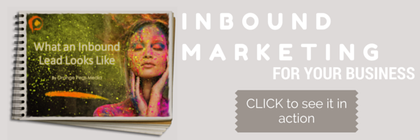
In this blog series we will be highlighting my marketing agency's journey to and through our transition into a full-suite inbound marketing agency. Inbound VS outbound marketing is
a hotly debated subject, and we are all in.
.
So, how do you determine what is right for you when everybody is screaming that THEY have the magic bullet solution to all of your outreach problems?
SEO, social media management, hashtags,
blogging, digital marketing... it can get overwhelming and certainly cumbersome to business owners and creative leaders trying navigate through these muddy waters while trying to carry out other, critical duties.
Personally, I am putting my time as a social media consultant behind me, because I found something better, and I want to take you through my journey to help you find direction in yours.
When I began my mission to reinvent the Orange Pegs model, I went through a series of discoveries that changed EVERYTHING, and it wasn't long before I realized how limited I actually was just offering the one discipline. Sure, I built a successful career in b2b sales, and throughout I used a lot of these inbound marketing concepts and technologies. However, when I scaled my personal model to fit a business, I was running into all sorts of issues... from narrowing in on my audience, to moving them through the pipeline after capturing their interests with organic marketing methodologies.
So, I hit the "pause" button, took three deep breaths, and came up with a strategy to find the best solution.
Step 1: Connect with Industry Professionals & Ask Questions
One of the best things you can do in the beginning is join network forums on LinkedIn, and attempt to spark conversations with other professionals doing the work and going through the same journey as you.
.
I was personally met with a wide array of responses, including a very divided set of opinions that supported an contrasted my thoughts, which was revealed through a whole lot of interesting banter. However, this didn't lead me to the answers, but rather, helped to start asking the right questions. For me, it was a response by a gentleman on this
thread that got me there...
I also love using Twitter for business. Following those you'd like to emulate helps you build the tool-set necessary to compete.
Step 2: Make Bold Statements
Don't be afraid to make proclamations that could be wrong. Sometimes it takes conversation to get to the right answer.
.
In my journey was frustrated at the splintered ideologies AND solutions that others brought to light, but I was also very encouraged, because this kind of marketing industry fragmentation can lead to huge victories for those who find ways to tie it all together. The most exciting part (for me) was how lost business owners and creative agents seemed to be when it came to these newer concepts.
.
Make bold statements. Tell people how you feel, and see how they react. It's amazing how much you can learn from people who don't like what you have to say. But remember, you may be wrong, and be willing to admit it, if at the very least, to yourself.
Step 3: Talk to Prospective Clients - Find the Pressure Points
I know that when those precious first leads start populating through our marketing mechanisms, it can be incredibly stressful. You don't want to screw up your first chances at revenue by sounding desperate, unqualified, or unintelligent, and you don't want to over-promise or come off like a used-car salesperson. Many of you may ignore your leads or put them through a series of email blasts. But I say pick up the phone, and call them.
.
The reality is that if your marketing is solid, you'll find other leads. Talking to a live person is your best chance to find out the pressure points from your prospective clients first-hand. The worst thing they can tell you is "no," but that shouldn't deter you. After experiencing rejection is the best time to make adjustments, and if you're not pushing yourself toward failure, you aren't trying hard enough.
Step 4: Experiment, Analyze, Repeat
Sign up for the 30-day trials!
.
I tried all sorts of different platforms (my favorite for awhile was Hootsuite), combinations of software publishing and reporting tools, email templates and methodologies... I redesigned some aspect of my website almost every day, viewed hundreds of videos, read dozens of ebooks, and ran alternating paid campaigns on Bing, Google, Facebook, LinkedIn, Twitter, and Google+.
.
I was glued to Google Analytics, and constantly tweaking my approach. Some days I would scrap everything and start completely fresh. The reality is that if I'M not happy with the results that I'm driving for my business, how can I expect my next client to be?
Step 5: You must choose... but choose wisely!
After several months of banging my head against the wall the answers started forming in front of me.
-
The fragmentation and varying ideas between industry peers showed me how much room there is to grow in this industry.
-
My methods needed to change if I was going to be competitive. Social media consulting by itself wasn't enough.
-
Business owners typically want hard figures showing their marketing ROI and prefer more comprehensive, all-in-one solutions.
-
Google Analytics only tells part of the story, doesn't refresh until the following day, and I am almost 90% certain that the majority of my site's traffic was generated by me reviewing my website changes. Social media management tools found within their platforms work better, but once the prospective customer clicks the link or fills out the relevant form, they are no longer trackable that way. Hootsuite has analytics, but again, tracking beyond generating site traffic requires additional tools and time. I also struggled with several of the plug-ins, such as the Unfollow app, and its reporting tools only allowed me to view one premium report at a time.
Throughout the entire journey, lurking in the background was this concept called "inbound marketing." The idea was to develop leads where clients seek you out, which would thereby eliminate the need for cold-calling, and they were cultivated using a closed ecosystem of publishing and reporting tools. Through one program (Hubspot) I am now able to write my blogs, develop visual content, edit my website, create landing pages, run email campaigns. The best part? I can track leads and feed them right into a CRM system, allowing the sales teams quick and easy access. I can actually prove my marketing ROI.
.
Anyhow, that's what I'm told it can do, and I bought into it. The results, however, will speak for themselves.

After everything was said I done I learned that organic marketing is changing right in front of our eyes. Older methodologies are becoming obsolete, and those who embrace these new ideas are presented with unprecedented opportunities. Smaller businesses can go head-to-head better than ever with their juggernaut competitors, and we are all being held to a much higher standard of transparency and value. Truly, this is an exciting time to be part of this industry, and I look forward to sharing my findings with my new platform as they unfold.
Want to see what a lead generated through inbound marketing actually looks like? Click
HERE:
.




